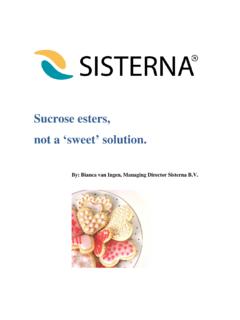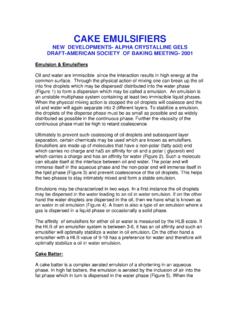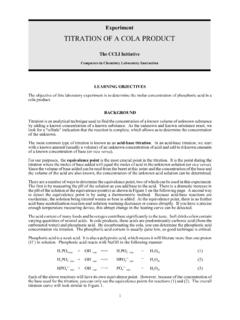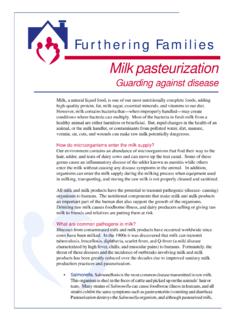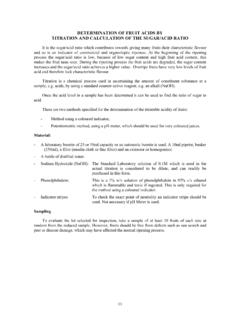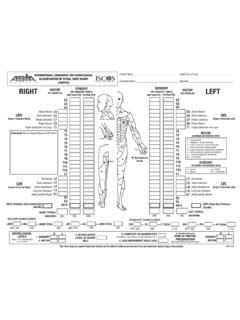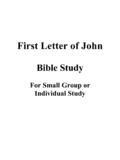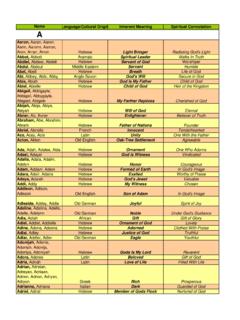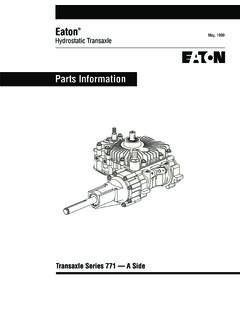Transcription of 10/07/2011 Soft Drink Components - Fantastic Flavours
1 10/07/2011 . soft Drink Components component Function Typical Use Level Water up to 95%. Sugars 7 - 14%. Carbon Dioxide 0 - Acids - Flavours - Juices 0 - 20%. Colouring 0 - 200 ppm Preservative 0 - 400 ppm Foaming Agent 0 - 200 ppm Hydrocolloids 0 - Cloudifiers 0 - Vitamins/Mineral/ variable Fibre soft drinks and Flavours ARP 1995 1. 10/07/2011 . Relative Sweetness of Sweeteners Sugar Index Sucrose 100. Dextrose (glucose) 70-80. Levulose (fructose) 140. 70-DE corn syrup 70-75. High conversion corn syrup 65. Regular conversion corn syrup 50. Maltose 30-50. Lactose 20. High fructose corn syrup 90% 120-160. 55% >100. 42% 100. Invert sugar >100. Sorbitol 50. Xylitol 100. Artificial Sweeteners Sucrose = 1.
2 Aspartame 100-200. Saccharin 400-500. Cyclamate 40-50. Thaumatim 2000-2500. Acesulfame K 200. Sucralose 600. soft drinks and Flavours ARP 1995 2. 10/07/2011 . Relative amounts of acid to produce an equal acidic taste: Citric 100. Tartaric 100. Phosphoric 90. Lactic 125. Malic 80. Acidity levels in Fruit Juices Average as Citric w/w Orange Lemon Lime Grapefruit Apple Pineapple soft drinks and Flavours ARP 1995 3. 10/07/2011 . soft drinks and Flavours Flavours AND OTHER INGREDIENTS FOR soft drinks Comment [TP1]: soft drinks are consummed mostly for pleasure, but may also have functional uses and be designed to replace salts lost during exercise, to supply vitamens and other nutrients. TABLE 1: Components of a soft Drink component Typical use level water up to 95%.
3 Sugars 7 - 14%. carbon dioxide 0 - acids - Flavours - juices 0 - 20%. colouring 0 - 200 ppm preservative 0 - 400 ppm foaming agent 0 - 200 ppm hydrocolloids 0 - cloudifiers 0 - vitamins/mineral/fibre variable Water used in the beverage industry has to be treated to remove undesirable substances and to control the alkalinity. A Drink made from untreated water or water of poor quality would result in off tastes in the finished beverage. Carbon dioxide is added to most soft drinks . Carbon dioxide dissolves readily in cold water under pressure and gives a sparkling appearance to the Drink when poured. It also enhances the flavour and gives a pleasant refreshing 'lift' to the Drink . Carbon dioxide also contributes to the inhibition of micro-organisms, particularly at higher carbonation volume.
4 Some products such as Cola beverages do not need the addition of preservative. The spice oils, low pH, lack of nutrients and the high carbonation are preservative enough. Flavour is an essential component in all soft drinks . Without the addition of a flavouring most drinks would taste like sweetned acidified water! From a leglislation point of view , flavourings come in three forms:- (1) natural (extracts and volatile oils). (2) Nature identical Flavours .( produced synthetically but are identical to naturally occurring chemicals. (3) synthetic flavourings which have not been found to occur naturally. There exists a fourth catogery called "WONF" (With Other Natural Flavourings). This mainly is used in the USA but some other countries adapt this classification for natural Flavours .)
5 All the materials used in these Flavours come from a natural source but not the named fruit. Thus orange WONF could have some mandarin oil added or some natural citral. The creation of new flavourings is a highly skilled job and the flavourist has at his disposal over 3000 individual flavouring ingredients. A typical flavour can consist of over 20. soft drinks and Flavours ARP 1995 4. 10/07/2011 . individual ingredients dispersed in a solvent or homogenised into an emulsion. By far the greatest group of flavourings used in citrus beverages are natural materials obtained by extraction or distillation from the citrus peel-which is usually pressed to obtain the essential oil, or extracted with alcohol to obtain the oil plus other flavour ingredients.
6 Juice oils which come from juice concentration are now used to give a more juicy taste. This oil can be used in beverages by three different techniques (refer pages 6 & 7). Fruit juices vary greatly in intensity of flavour. Orange juice, for example, has only one-tenth the flavour impact of passionfruit juice. Juices are usually concentrated six to ten times at the point of processing. This reduces storage space, particularly if they are to be refrigerated, and transportation costs to the market place. In concentrating, some if not all of the volatile Flavours are lost, hence the need to add back Flavours . Juices give a flavour profile to drinks which is difficult to obtain otherwise, and also add to the appearance and mouth feel.
7 They also satisfy the consumer demand for health giving properties in a Drink . Colouring influences the taster's reception of the Drink . We taste with our eyes. The colour properties can be affected by many of the beverage ingredients and good storage stability is required in the presence of acids and preservatives. The colour must also be stable in the presence of light. There are two main classes of beverage colouring - natural/nature identical colours and artificial colourings. Commonly used synthetic colours in Singapore, Malaysia, Indonesia, Thailand, Australia, Hong Kong, Japan, UK, USA are: Ponceau 4A All above except USA. Carmosau All above except Indonesia & USA. Amaranth All above except Malaysia, Thailand & USA.
8 Tartrazine All above Brown HT Australia and Malaysia Sunset Yellow All above Quinolene Yellow Indonesia, Hong Kong, UK only Brilliant Blue All above Indo carmine All above Green S All above except Malaysia, Thailand, Japan & USA. soft drinks and Flavours ARP 1995 5. 10/07/2011 . SUGAR PROFILES AND CHARACTERISTICS FOR JUICE CONCENTRATES. The major Components of fruit juice concentrates are sugars, followed by water, nutrients, acids, colour pigments and flavour Components . These sugars are a natural source of sweetness and perform as functional ingredients in a wide variety of applications. THE PREDOMINANT SUGARS ARE: FRUCTOSE is a reducing sugar frequently found in fruits. It provides about 30% more sweetness than sucrose and has excellent moisturising properties due to its humectant nature.
9 GLUCOSE is also a reducing sugar frequently found in fruits and is about 20% less sweet than sucrose. Glucose crystallises readily in concentrate solutions and provides less humectant properties than fructose. SUCROSE is a disaccharide and a non-reducing sugar. It has been established as the standard for measuring sweetness. Upon inversion in acidic solutions, sucrose converts to fructose and glucose. SORBITOL is a polyhydroxyl sugar alcohol, less sweet than sucrose, with a pleasing cool taste. It also provides humectancy. FRUIT SUGAR PROFILES % COMPOSITION. FRUCTOSE GLUCOSE SUCROSE SORBITOL. Apple 62 31 5 2. Peach 25 25 50 0. Pear 60 20 5 15. White Grape 48 48 4 0. Pineapple 15 25 50 0.
10 Orange 49 49 2 0. Sweeteners. There are two main groups of sweeteners used in the beverage industry - carbohydrates (sugars) and artificial sweeteners. Sugar enhances the taste of a Drink , gives it body and improves its mouthfeel. The sugars that are used in the beverage industry include sucrose, fructose, glucose, high fructose corn syrup and maltose. Of these the most commonly used is sucrose in the form of granulated white sugar, and high fructose corn syrup, a liquid, which is slightly cheaper than sucrose. Sucrose breaks down into fructose and glucose under the action of acid, time and temperature. soft drinks and Flavours ARP 1995 6. 10/07/2011 . Artificial sweeteners are high intensity sweeteners which are usually a few hundred times sweeter than sugar.
